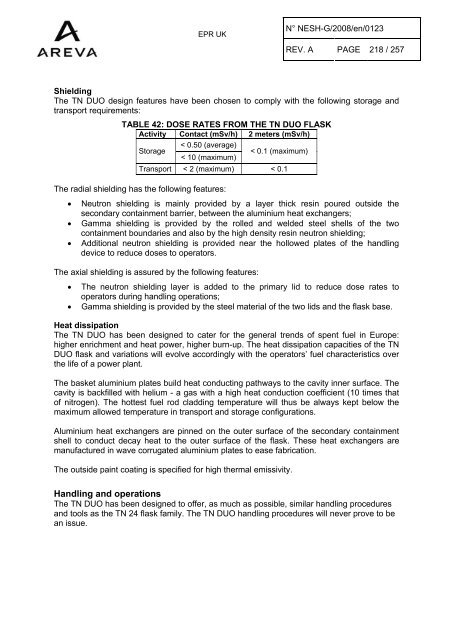Solid Radioactive Waste Strategy Report.pdf - UK EPR
Solid Radioactive Waste Strategy Report.pdf - UK EPR
Solid Radioactive Waste Strategy Report.pdf - UK EPR
Create successful ePaper yourself
Turn your PDF publications into a flip-book with our unique Google optimized e-Paper software.
<strong>EPR</strong> <strong>UK</strong><br />
N° NESH-G/2008/en/0123<br />
REV. A PAGE 218 / 257<br />
Shielding<br />
The TN DUO design features have been chosen to comply with the following storage and<br />
transport requirements:<br />
TABLE 42: DOSE RATES FROM THE TN DUO FLASK<br />
Activity Contact (mSv/h) 2 meters (mSv/h)<br />
Storage<br />
< 0.50 (average)<br />
< 10 (maximum)<br />
< 0.1 (maximum)<br />
Transport < 2 (maximum) < 0.1<br />
The radial shielding has the following features:<br />
· Neutron shielding is mainly provided by a layer thick resin poured outside the<br />
secondary containment barrier, between the aluminium heat exchangers;<br />
· Gamma shielding is provided by the rolled and welded steel shells of the two<br />
containment boundaries and also by the high density resin neutron shielding;<br />
· Additional neutron shielding is provided near the hollowed plates of the handling<br />
device to reduce doses to operators.<br />
The axial shielding is assured by the following features:<br />
· The neutron shielding layer is added to the primary lid to reduce dose rates to<br />
operators during handling operations;<br />
· Gamma shielding is provided by the steel material of the two lids and the flask base.<br />
Heat dissipation<br />
The TN DUO has been designed to cater for the general trends of spent fuel in Europe:<br />
higher enrichment and heat power, higher burn-up. The heat dissipation capacities of the TN<br />
DUO flask and variations will evolve accordingly with the operators’ fuel characteristics over<br />
the life of a power plant.<br />
The basket aluminium plates build heat conducting pathways to the cavity inner surface. The<br />
cavity is backfilled with helium - a gas with a high heat conduction coefficient (10 times that<br />
of nitrogen). The hottest fuel rod cladding temperature will thus be always kept below the<br />
maximum allowed temperature in transport and storage configurations.<br />
Aluminium heat exchangers are pinned on the outer surface of the secondary containment<br />
shell to conduct decay heat to the outer surface of the flask. These heat exchangers are<br />
manufactured in wave corrugated aluminium plates to ease fabrication.<br />
The outside paint coating is specified for high thermal emissivity.<br />
Handling and operations<br />
The TN DUO has been designed to offer, as much as possible, similar handling procedures<br />
and tools as the TN 24 flask family. The TN DUO handling procedures will never prove to be<br />
an issue.

















